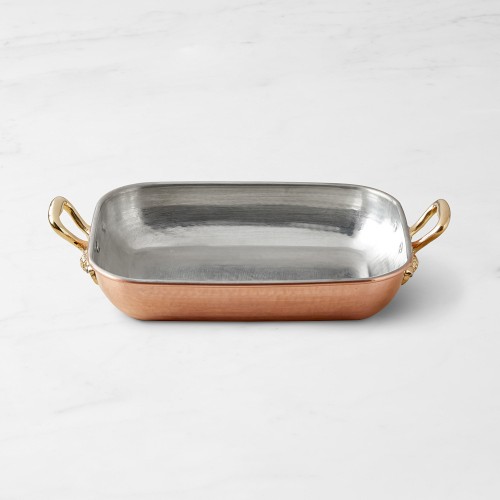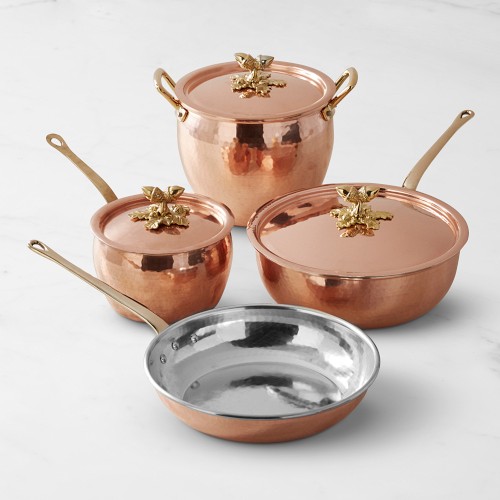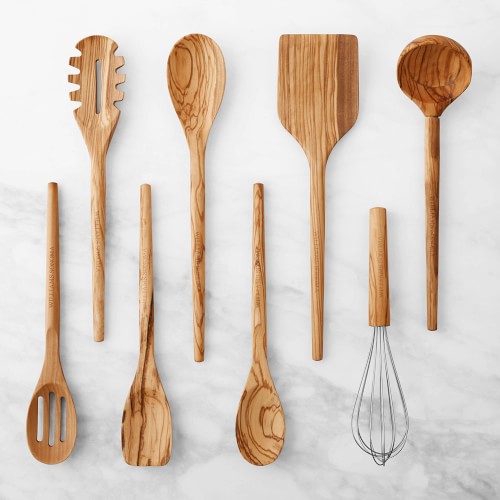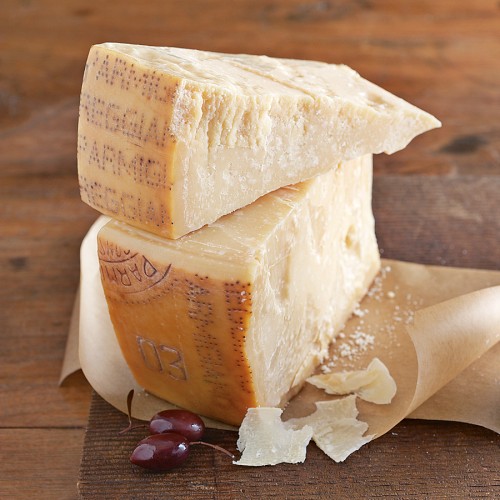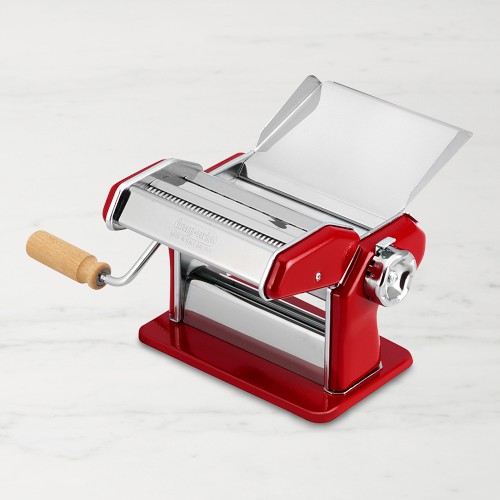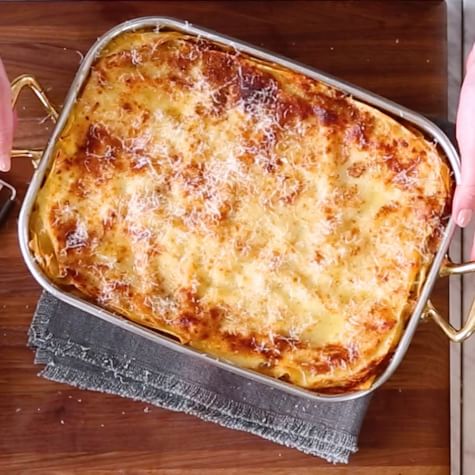
Lasagne alla Bolognese
“In Italy, there are almost as many variations of lasagne as there are families,” says Rita Ruffoni. “The most traditional lasagne from Bologna, for example, is completely different from that of Napoli. Even in the same region, small differences exist on seasoning, proportion of veg to meat, cooking time, etc. This is the Ruffoni family’s take on it.”
Ingredients:
For the Bolognese:
- Extra-virgin olive oil as needed
- 1 lb. (500 g) ground pork
- 1 lb. (500 g) ground beef, preferably 20% fat
- 1 yellow onion, finely chopped
- 2 carrots, finely chopped
- 2 celery stalks, finely chopped
- 1 garlic clove, smashed (optional)
- 2 Tbs. tomato paste
- 1 sprig fresh rosemary, 2 bay leaves and 3 fresh sage leaves, tied together with twine
- Kosher salt and freshly ground pepper
- 1 cup (8 fl. oz./250 ml) dry red wine
- 2 cans (each 14 oz./440 g) chopped plum tomatoes
- 1 Parmigiano-Reggiano rind (optional)
For the pasta:
- 2 cups (10 oz./300 g) all-purpose flour
- 3 eggs
- Pinch of kosher salt
- 1 Tbs. olive oil
For the béchamel:
- 4 cups (32 fl. oz./1 l) whole milk
- 1 stick (4 oz./125 g) unsalted butter
- 3/4 cup (3 1/2 oz./110 g) all-purpose flour
- Kosher salt
- Freshly grated nutmeg
- 1/2 cup (2 oz./60 g) grated Parmigiano-Reggiano
For assembling:
- Unsalted butter, as needed
- 2 cups (8 oz./250 g) grated Parmigiano-Reggiano
Directions:
In a large braiser over medium heat, warm enough olive oil to cover the bottom of the pan (about 3 Tbs.). Add the ground pork and cook, stirring occasionally to break up any large clumps, until nicely browned, about 5 minutes. Using a slotted spoon, transfer the pork to a bowl and set aside.
If the pot seems dry, add a splash of olive oil. (If the ground pork was fatty, there will already be enough oil in the pan for the next step, but if it was lean, you might need another 2 to 3 Tbs. olive oil). Add the ground beef and brown for a few minutes, stirring to break up any large clumps, until the liquid has mostly evaporated and the meat is nicely browned. Using a slotted spoon, transfer the beef to the bowl with the pork.
If the pot seems dry, add another 1 to 2 Tbs. olive oil. Add the onion, carrots and celery, reduce the heat to medium-low, and sauté until the vegetables are softened and the onion is translucent but not browned, about 3 minutes. Add the garlic, if using, the tomato paste, and the herbs. Season with salt and pepper and cook, stirring, for 1 minute.
Return the pork and beef to the pan and stir to combine. Increase the heat to medium-high. Add the wine, stirring to scrape up any browned bits from the bottom of the pot, and cook until most of the liquid has evaporated, about 3 minutes.
Add the tomatoes and the Parmigiano-Reggiano rind, if using. Bring to a simmer, then reduce the heat to maintain a bare simmer. Cover the pot and simmer gently, stirring occasionally and adding a little water if it looks like it’s drying out too much, for at least 2 hours, and up to 4 hours.
Remove and discard the Parmigiano-Reggiano rind, garlic clove and herb bundle. Season to taste with salt and pepper.
When the Bolognese is about halfway through cooking, make the pasta: In a large bowl, stir together the flour, eggs and salt until thoroughly combined. Turn out onto a lightly floured surface and knead until smooth and elastic, about 15 minutes. Return the dough to the bowl, cover the bowl with plastic wrap and let the dough rest for 1 hour.
Divide the dough into three pieces. Working with one piece at a time, and leaving the remaining pieces in the bowl covered with plastic wrap, on a lightly floured work surface, use a rolling pin to roll the dough into a rectangle about 1/2 inch (12 mm) thick and no wider than your pasta roller. Roll the dough through the rollers once at the widest setting, then place the dough on the work surface and fold it into thirds. Repeat the process 2 more times, rolling the dough through the rollers at the widest setting and folding it into thirds each time.
Now thin the dough by rolling it through the rollers at the second-to-widest setting. Repeat, setting the rollers one notch narrower each time, until the dough is about 1/16 inch (2 mm) thick. Place the dough sheet on your floured work surface and use a sharp knife to cut into rectangles that will fit into your roasting pan. Cover with plastic wrap until ready to use.
To make the béchamel, in a saucepan, warm the milk just until small bubbles appear along the edges of the pan; do not let it come to a boil. Remove from the heat and cover to keep warm.
In a large saucepan or sauté pan over medium heat, melt the butter. When it begins to foam, add the flour and stir well with a wooden spoon or silicone whisk. Reduce the heat to low and cook the roux, stirring constantly, until it starts to turn golden but hasn’t browned. Add a ladleful of the hot milk, and whisk well until no lumps remain, then add the rest of the hot milk. Whisk until thoroughly combined. Season with salt and nutmeg to taste, then continue cooking until slightly thickened, about 5 minutes more.
Turn the heat off, add the Parmigiano-Reggiano and stir well to combine. Cover to keep warm and set aside.
To cook the pasta, bring a large pot of salted water to a boil over high heat. Stir in the 1 Tbs. olive oil. Add the pasta rectangles to the water one or two at a time, stirring to prevent them from sticking, and cook until slightly softened but still quite firm to the bite, about 30 seconds. As the pasta is finished, arrange the pieces in a single layer on a clean, lint-free kitchen towel,
Preheat an oven to 350°F (180°C).
Lightly butter the bottom and sides of a roasting pan or a lasagne pan.
To assemble the lasagne, spread a couple of spoonfuls of the béchamel on the bottom of the pan, then cover with a single layer of the cooked pasta sheets. Spread some of the Bolognese on top of the pasta to cover, then sprinkle generously with Parmigiano-Reggiano and cover evenly with a few more spoonfuls of the béchamel. Continue layering the ingredients, repeating the layers of pasta, Bolognese, Parmigiano-Reggiano and béchamel, until you have used most of the ingredients and have at least four or five layers. Finish with a layer of pasta, béchamel, and plenty of Parmigiano-Reggiano. Top the surface of the lasagne with about 2 Tbs. of butter, cut into small pieces.
Bake until the lasagne is hot and bubbling, about 30 minutes, checking once or twice to make sure the top isn’t browning too much; if it is, cover the pan with aluminum foil while it finishes cooking.
Let cool slightly, then serve at the table, cutting into squares. Serves 8.
Recipe courtesy of Rita Ruffoni













